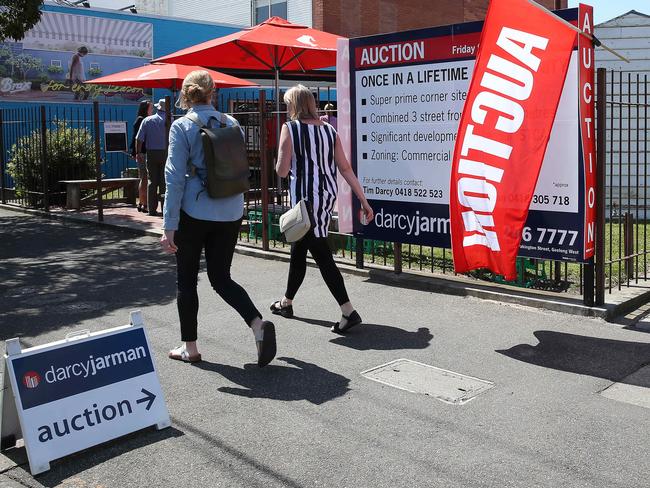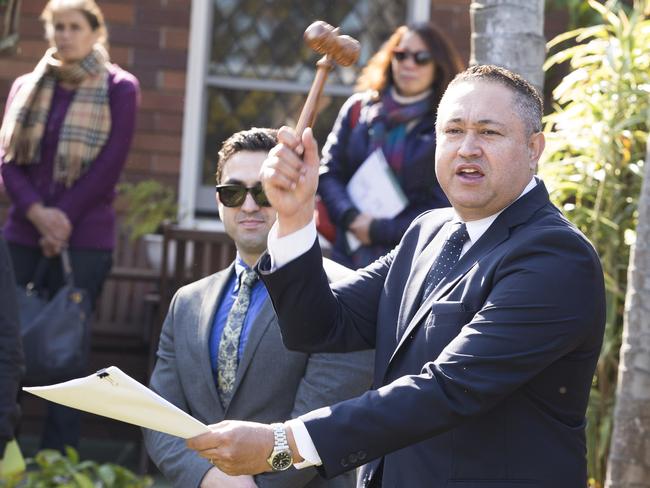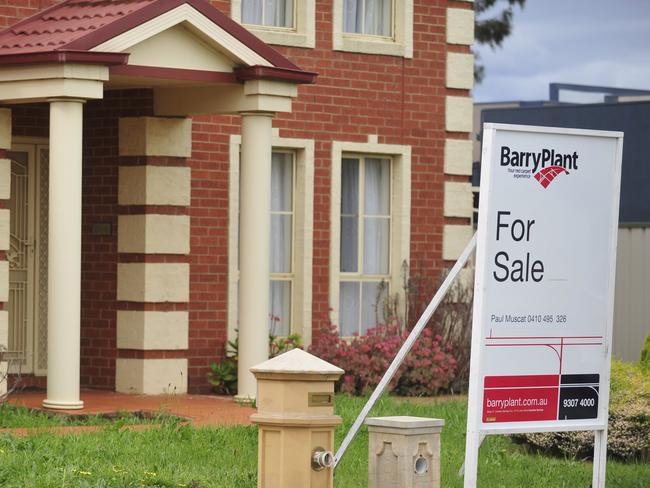Real estate industry insiders say property prices look set to fall
EXPERTS are saying Australia’s housing boom has hit its peak — some are hinting at a recession. But is it part of the normal cycle?
THINK real estate is the ticket to get rich quick? Think again.
But if you’re actually looking for a home to live in, then your money is probably as safe as houses.
Some economists and analysts are saying Australia’s housing price boom has hit its peak — and some are even hinting at an impending recession. But other industry insiders say a price “correction” is just part of the normal cycle.
Investment bank Macquarie yesterday put its cards on the table, tipping that house prices are set to fall by as much as 7.5 per cent, starting in March 2016, with a recovery commencing in the second half of 2017.
“Credit growth, auction clearance rates, house prices, settlement volumes and the dollar value of settlements are all showing signs of slowing, albeit from lofty levels,” analysts said in a note yesterday.
“Our economics team are forecasting quarter-on-quarter house prices to fall from the March 2016 quarter before beginning to recover from June 2017, with a 7.5 per cent fall from peak to trough.”
It said the issue was easing population growth just as housing supply surged well above trend, raising the risk of prices going through a “rapid adjustment”.
Depending on the speed of the adjustment, Macquarie argues the Reserve Bank may be forced to cut rates by a further 25 basis points to support demand and prices.
Credit Suisse has also warned about the deterioration in buying conditions, particularly in NSW. “Macro-prudential tightening, out-of-cycle rate hikes on investor mortgages, and weakness in Chinese buying are having a clear impact on sentiment and demand,” it said.
And Bank of America Merrill Lynch also joined the chorus, warning of “never before observed” dwelling price to income ratios of five-and-a-half times and record high household debt levels.
“We are not forecasting collapse or the bursting of any perceived bubble,” it said in a note yesterday. “That said, it is not difficult to envisage a more hard landing scenario in the property market. This would clearly have a greater negative macroeconomic impact channelled through households and the residential construction cycle.”
Both the ANZ and Commonwealth Bank have indicated a tightening of lending to property developers due to oversupply fears as the market cools.

BUBBLE IS ‘BLATANTLY OBVIOUS’
Lindsay David, founder of LF Economics and author of Australia: Boom to Bust, said all the data showed it was “blatantly obvious [that] Australia has one of the largest housing bubbles in modern Western history”.
“APRA since its inception has done nothing to stem the insanely rapid sums of debt Australian households have accumulated which now stands at 120 per cent of GDP,” he said. “This is simply an insane figure.”
Mr David said his research suggested the major banks were setting their mortgage teams incredibly high growth targets, and that the regulator’s recent macroprudential rules introduced in a bid to slow investor loans had simply shifted banks’ focus back to lending “irrational sums of debt” to owner occupiers.
“When you dive into the mortgage books and balance sheets of our major banks who have been lending to homebuyers like there’s no tomorrow, they resemble a toxic dump of debt with hardly a shred of capital to cover a significant fall in house prices or mortgage defaults,” he said.
The reality, he said, is that Australia’s banking system created too many artificial property buyers through rapid mortgage debt growth.
“History tells us it doesn’t matter how many new dwellings a nation builds, when leveraged speculation if rife, there will always be more buyers than sellers in the housing market followed by the complete opposite occurring,” he said.

WHAT DOES THAT MEAN FOR YOU?
Don’t panic, because this is normal.
That’s the message from Tim Lawless, senior analyst at property data firm Core Logic.
“Property values do go backwards, we’ve demonstrated that plenty of times in the past,” he said.
“In fact the past correction, between October 2010 and June 2012, we actually saw values fall by about 7.4 per cent (at a capital cities level), which is about what Macquarie Bank is saying right now,” he said.
“I think a 7.5 per cent fall is probably a reasonable expectation when you look back through history,” he said.
“We’ve already seen the housing market go through a really strong growth phase for nearly three and a half years now. That’s quite a long growth phase and normally you wouldn’t expect to see prices grow at this pace for so long,” Mr Lawless said.
He said particular markets across the country that are more exposed to a downturn in property prices are the area where there has been the most price growth and where conditions have been “imbalanced”.
Rather than talk of bubbles bursting, Mr Lawless said those markets which have been booming in recent years will see a price “correction”.
“During periods when values have gone backwards, they generally haven’t gone backwards by a substantial amount,” he said.
“I’d say that if the past is anything to go by, and this is what we’ve got to look forward to, we will see some falls in the larger capital cities, particularly in Sydney and Melbourne because we have seen values grow at a substantial pace compared to incomes and rents. It makes sense that values will rebalance themselves,” he said.
Mr Lawless said while the big “macro” market numbers are favoured by banks, househunters should look closer to home.
“I think they need to look at their own plans. For anyone who’s looking at holding their home for a long time, if they’re buying a principal place of residence and are expecting a long tenure there then it’s not that big a deal to get the timing right,” he said.
“But if you are an investor, or if you’re looking at potentially selling it in relatively short space of time, then the timing becomes a lot more important,” he said.
“At an individual suburb level, and down towards the micro areas of a neighbourhood, there are always going to be different opportunities and different challenges in the market. So it’s up to individual buyers to really nut out what the conditions are like below that capital city boundary and look at what’s happening in the particular markets,” he said.

PRICE CRASH NEEDS A TRIGGER
Leading economist Saul Eslake played down the immediate danger of a large fall in house prices. For that to happen, he said, there would need to be a combination of a significant number of forced sellers through mortgage defaults and an oversupplied market.
The first is unlikely due to low interest rates which are likely to remain so for some time, and relatively large buffers built up by mortgage holders who have taken advantage of those low rates.
“I don’t think there is any immediate danger of a significant fall in house prices — 7.5 per cent is remarkably precise and you’re brave to be that precise in forecasts about the housing market,” Mr Eslake said.
He argued even though house prices might be overvalued, that didn’t mean they’re going to fall in the same way as stocks. With home ownership still at around 67 per cent, the majority of people own property to live in.
“I can accept that housing looks overvalued by various metrics, but that of itself isn’t the issue,” he said. “Asset prices are almost always overvalued or undervalued — the proportion of time that any asset is exactly at fair value is very small — but that doesn’t necessarily mean they will fall. Something has to happen to trigger that.”
Mr Eslake has previously predicted the probability of Australia falling into recession in 2015 or 2016 as the mining boom unwinds at around 25 per cent. He said the recession danger doesn’t come from house prices per se, but from homeowners forced to save more to pay off their mortgages, slowing consumer spending.
“The biggest risk is not to the financial system, because Australian banks are fairly well capitalised, and Australians have been historically reluctant to default on mortgage debt. It’s what they do to reduce the chances of that happening,” he said.
AMP Capital chief economist Dr Shane Oliver is tipping a 5-10 per cent fall, but more likely some time in 2017, and only if the RBA hikes rates. “My feeling is we’re on a period of deceleration, where prices continue to rise but at a much slower rate,” he said.
He pointed out that the so-called housing boom has only really been in Sydney and Melbourne, with half the capital cities already in decline, but particularly Perth and Darwin.
Dr Oliver said he puts the likelihood of recession at just 20 per cent. “The biggest worry is housing approvals are at very high levels, up around record levels recently, but it’s the momentum that counts,” he said.
“If they top out or go sideways, which looks likely, then the contribution to growth from housing construction will fall back to zero over the next 12 months.”




